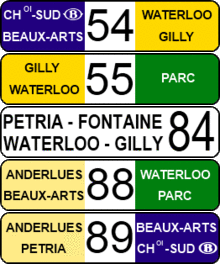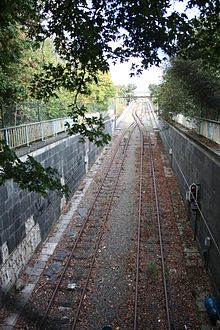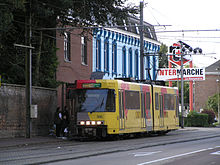- Charleroi Metro
-
The Charleroi Metro (French: Métro léger de Charleroi, sometimes abbreviated as MLC, generally referred to as the Metro, or Métro de Charleroi in French) is a 25 km (16 mi) express tram network in Belgium, consisting of a horseshoe-shaped line around central Charleroi and two branches towards the suburbs of Gilly and Anderlues. It was built between 1976 and 1996 with 26 stations, of which 20 are in service as of 1996, and 6 regular tram stops in Anderlues. The original plans were much more extensive, but had to be abandoned due to high costs and low prospective passenger numbers, and some largely completed sections have never been opened. Expansion works have begun again in 2008 and are currently (as of 2011) underway.
Contents
Lines and operation
An unfinished loop line currently runs around the city centre, from Sud (at the main railway & bus station) to Parc, as well as two branch lines to Gilly and Monument (in Anderlues). The branch towards Anderlues runs on the street as a normal tram after Pétria station, following a line of the old Vicinal network.
Five tram lines (54, 55, 84, 88, 89) operate over metre-gauge track, on a mix of tunnels, viaducts, and cuttings, or at ground level.
Lines of the Charleroi pre-metro network Line Itinerary Length Stations Interval
(weekdays)Interval
(weekdays during school holidays)Interval
(Saturdays)Interval
(Sundays and public holidays)54 Sud — Gilly 5.38 km (3.34 mi) 8 10
(15 between 6PM and 8PM)15
(20 between 6PM and 8PM)20
(30 between 6PM and 8PM)55 Parc — Gilly 3.45 km (2.14 mi) 6 10
(15 between 5AM and 6AM, and 6PM and 8PM)15
(20 between 6PM and 8PM)20
(30 between 6PM and 8PM)84 Pétria — Gilly 14 km (8.70 mi) 15 Only one morning service (No service) 88 Parc — Anderlues-Monument 16.35 km (10.16 mi) 14
+ 6 tram stops30 60 89 Sud — Anderlues-Monument 16.1 km (10.00 mi) 16.28
+ 6 tram stops30 60 Intervals are in minutes.
All lines except 55 serve Beaux-Arts station in the city centre, and all lines except 89 serve Waterloo station. Line 84 is a special morning rush hour line with only one service a day, which is generally not mentioned on network maps or station signs, but appears on the lines 88/89 official timetable.
The system is run by TEC Charleroi, a subsidiary of the Walloon public transport operator (Société Régionale Wallonne du Transport).
Station entrances are marked with a stylized white "M" on a blue background, identical to the symbol used by the Brussels metro. Access to the platforms is unrestricted (no gates/barriers) and most stations are not staffed. A couple of stations are equipped with automatic ticket vending machines, otherwise tickets are sold directly by the tram driver.
Unlike in most metro systems, signs in Charleroi Pre-metro stations lack coherence as they do not always indicate line numbers and final station. For example, directions for line 89 can be shown as "89 vers Sud" or "Vers Charleroi" (without line number) depending on the station. Additionally, no standardized colors are defined for line numbers and other various signs. As a general rule, signs for lines 88 and 89 toward Anderlues-Monument always display "Anderlues" (without any reference to the Monument terminus stop).Similarly, destination display on tram uses various layouts. The most common display shows two distinctly colored rectangles indicating the most important stations of the line, with the line number displayed on a white square between both rectangles. Rectangle color uses the following code :
- Pale yellow : used on lines originating/terminating in Anderlues.
- Bright yellow : used on lines originating/terminating at Gilly.
- Dark blue : used on lines originating/terminating at Sud.
- Dark green : used on lines originating/terminating at Parc.
Beside this system, it happens that trams only display the terminus station as one of Charleroi-Sud (dark blue background) or Parc (green), without line number. Line 84 uses a completely different display with black characters on a full white background and line number on the right. A few trams are equipped with orange LED destination displays, indicating line number and final station in a way similar to most other tram/metro systems.
Trams drive on the right track, except on the Gilly branch and the not operated Châtelet branch. Some small sections on the street in Anderlues (and in Gosselies on the future Gosselies branch) are single track. Theoretical maximum speed on the network is 65 km/h (40 mph), but actual speed is generally lower, especially in curves[1]. Speed limits are displayed on panels along the track and can take one of the following kph values : 10, 17, 25, 35, 45, 55 and 65. Rail switches are controlled directly by tram drivers using a remote control unit sending a signal to a receiver along the track.List of stations
Main article: List of Charleroi Pre-metro stations
History
The Charleroi Pre-metro was planned in the 1960s as a 52 km (32 mi) network, consisting of eight branch lines radiating from a central downtown loop and no less than 69 stations.[2]. If completed as planned, this would have been the largest metro system in the Benelux region.
In the 1960s, Charleroi already had an extensive tramway network, operated by both SNCV and STIC, but trams were starting to be replaced by buses as those offered better flexibility, were cheaper to operate and were perceived as more modern. The pre-metro network was meant to offer trams a second life by providing a fast and comfortable mass transit system, while removing them from the street.
Full completion of the initial project was envisioned between 1992 and 1994. As a general rule, plans called for tracks to be at ground level, on dedicated infrastructure (separated from the street). If not possible, priority was given to viaducts, and tunnels were considered as the last option, except in Charleroi downtown or in densely populated areas.
The first section opened on 21 June 1976, between Sud and Villette (which was the first metro station in Belgium to be built on a viaduct).
Piges and Ouest were opened 4 years later, on 30 June 1980. Each time a new section was inaugurated, trams would transit through it before going back to the street for the remainder of their journey.
Stations Beaux-Arts, Dampremy, and the section between Morgnies and Paradis were opened on 24 May 1983. Pétria followed on 24 May 1986. The same year, works were completed on a first section of the Châtelet branch (until Centenaire station), however this branch has never been put into service.
The remaining stations on the Anderlues branch (Providence, De Cartier, Moulin and Fontaine) were opened on 22 August 1992. One week later, on 28 August, a first section of the Gilly branch (from the downtown loop until Gilly)) was inaugurated, along with the Waterloo station on the downtown loop. Infrastructure beyond Gilly to Soleilmont is in various stages of completion, but not in service. 54 was created to serve the new branch.
On 30 August 1996, two additional stations were opened on the downtown loop (Janson and Parc). Lines 55 and 88 were created to duplicate the two existing lines while using the northern part of the unfinished loop.
2008 and 2009 saw the resumption of metro construction, following a 75 million Euro loan from the European Investment Bank[3], out of a total estimated cost of 150 million Euro. Work to complete the downtown loop started on 20 October 2008, building of the Gosselies branch on 16 March 2009, and the lengthening works on the Gilly branch toward Soleilmont started on 30 March 2009.
Future plans
Completion of the downtown loop
Construction on the missing downtown loop link between Parc and Sud began on 20 October 2008. The project consists in making tram tracks emerge to the surface south of Parc station, create a new stop (Tirou) in a busy downtown area, cross the Sambre on a dedicated new bridge, before reaching the Charleroi-South railway station following the Sambre banks.
The new bridge arrived by barge on the Sambre and was installed at the end of January 2011, in a spectacular operation[4].
As of September 2011, works on the project are in the final phase[5] and the section is scheduled to open to commercial traffic in the spring of 2012[6].
Extension of the Gilly branch to Soleilmont
This project consists in extending the Gilly branch of the network on approximately 1.75 km (1.09 mi) past Gilly toward Soleilmont, where a new multimodal (metro, bus, car, bicycle, pedestrian) transport hub is to be created. The project includes the creation of three new stations after Gilly :
- Marabout
- Sart-Culpart
- Soleilmont
Structural works of the Gilly to Sart-Culpart section, including Marabout and Sart-Culpart stations, had been carried out in the 1980s and left abandoned since then[7].
The new section is scheduled to open to commercial traffic in the spring of 2012.
Gosselies branch
This project aims at creating a new branch starting at Piges station and running as a regular tramway line toward Gosselies. A large section of the line already exists to the Jumet tram depot, but as it is only used by empty trams going to and from the depot, and is not equipped for commercial passenger transport, it has to be completely rebuilt. The Jumet to Gosselies section is new, although it is built on the site of former SNCV tramway lines.
The project includes full renovation of the Chaussée de Bruxelles (Brussels Road) which will be used by the new line.
Because of the narrowness of some streets in Gosselies, the line will will use single track in different streets for each direction.
The Gosselies branch was scheduled for completion in 2011, however multiple delays have meant an opening at the end of 2012 at the earliest[8].
Châtelet branch
The original pre-metro project envisioned an eastern branch from Waterloo station (then Nord) to Châtelet, comprising 8 stations. Construction of this branch began in the 1980s and resulted in a first 4 km (2.5 mi) section in various stages of completion.
The Waterloo to Centenaire part has been finished, but was never put into service. As a result, the Neuville, Chet, Pensée and Centenaire stations remained closed and were vandalized.
Only structural work was completed on the Centenaire to Corbeau part, with no tracks installed. The rest of the branch has never been built.Although there are no immediate plans to put the Châtelet branch into service, preliminary estimates give a cost of 5 million euros to refresh the Waterloo-Centenaire section, and another 20 million to complete the line to Corbeau (serving a nearby popular shopping mall)[9]. Plans to build the line until the intended Châtelet terminus are abandoned.
Rolling stock
Passenger cars
Charleroi's LRV cars are reversible articulated tramways which were supplied by La Brugeoise et Nivelles (BN) (with ACEC providing the motors and the electrical/electronic components) from 1980 to 1982.[10]. They are similar to the trams operated on the Belgian coast tram line (although those have doors on only one side) and, to a lesser extent, to the first generation trains of the Manila Light Rail Transit System yellow line.
According to an official statement by TEC Charerloi[11], 44 of these trams are operational, the future network with the completed downtown loop and the Gilly branch extension requiring 22, then 35 when the Gosselies branch opens.
Each unit has a length of 22.88 mm (0.0751 ft) for a width of 2.5 m (8.2 ft), and is capable of carrying 44 seated and 148 standing passengers (6 pax/sq m) for a grand total of 192 passengers[12]. It is powered by two electric engines providing a total power of 456 kW. Their maximum speed is 65 kph[13]. They can theoretically be coupled to form trains of up to three trams, however the single tram configuration is the preferred one on the Charleroi network, with only a few peak hour services on lines 54/55 and 84 being operated by 2 trams coupled together.
Trams exist in two liveries : the old SNCV livery with an orange bottom and beige top separated by a blue line (wearing a 4 digit number starting with 61), and the newer TEC Charleroi livery with its distinctive bright yellow, red and grey colors (wearing a 4 digit number starting with 74).Work Cars
Pre-metro work cars are cars from other European operators:
- Type S - SNCV Hainaut - work car
- Type SJ - SNCV Hainaut - passenger cars - acquired 1984
- Esslingen/Schorling tram - track scrubber - acquired 1981
See also
References
- ^ metrocharleroi.over-blog.com/5-index.html
- ^ http://www.urbanrail.net/eu/cha/charleroi-planned-network.gif
- ^ European Investment Bank 2007 press release.
- ^ M. Ad., Le pont du métro est installé, La Libre, 1 February 2011.
- ^ TRAVAUX DU METRO LEGER DE CHARLEROI - Le point avant la rentrée des classes, Charleroi police, 29 August 2011.
- ^ Report de la mise en service de la Boucle Centrale et de l'antenne de Gilly-Soleilmont, Official TEC Charleroi statement, 31 October 2011.
- ^ Le chantier carolo du siècle, page 9 : La renaissance de l'antenne gillicienne, La nouvelle gazette, 15 September 2009.
- ^ Le métro léger de Charleroi accuse un lourd retard, La Nouvelle Gazette, Charleroi, 29 June 2011.
- ^ Mathieu Colinet, Le Tec rêve de son métro oublié, Le Soir, Brussels, 26 July 2011.
- ^ [1]
- ^ Le TEC Charleroi sera prêt techniquement à accueillir son nouveau métro, La Nouvelle Gazette, Charleroi, 02 June 2011.
- ^ An original SNCV brochure mentions 98 standing pax at 4 pax/sq m, however indications inside trams mention a total capacity of 192, which equates to (192 total - 44 seats = 148 standing pax).
- ^ Les vicinaux - Ses autobus, ses tramways, SNCV, Brussels.
External links
- Official site of the TEC
- Urbanrail.net Charleroi site
- Photos from a 2003 trip along the Châtelet branch
- Trams-Trolleybus.be - Métro léger de Charleroi (French)
- Tram Travels: Charleroi
Line 54 Line 55 Parc • Janson • Waterloo • Samaritaine • Gazomètre • GillyLine 84 Pétria • Fontaine • Paradis • Leernes • Morgnies • Moulin • De Cartier • Providence • Dampremy • Piges • Beaux-Arts • Waterloo • Samaritaine • Gazomètre • GillyLine 88 Parc • Janson • Waterloo • Beaux-Arts • Piges • Dampremy • Providence • De Cartier • Moulin • Morgnies • Leernes • Paradis • Fontaine • Pétria • Coron du berger • Surchiste • Route de Thuin • Jonction • Route de la station • MonumentLine 89 Future Public transport in Belgium National 
Flanders Wallonia Société Régionale Wallonne du Transport — TEC — Charleroi MetroBrussels Categories:
Wikimedia Foundation. 2010.







